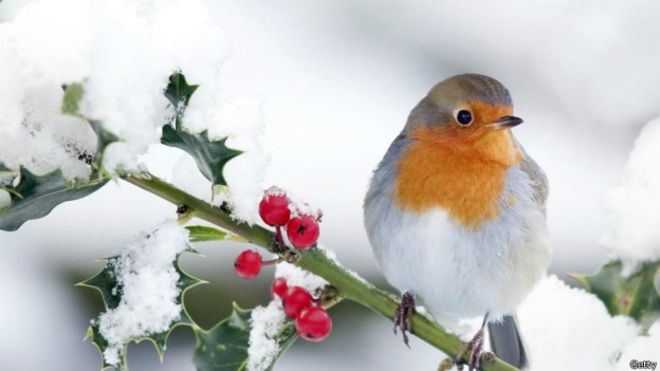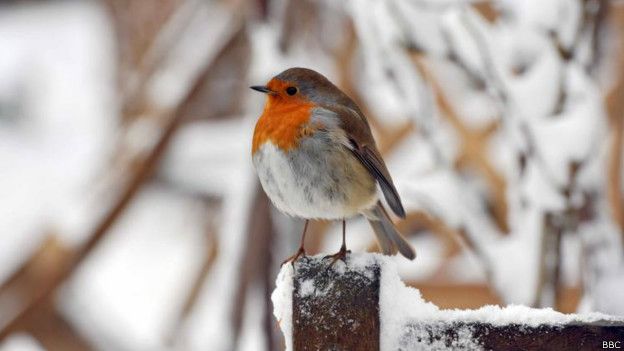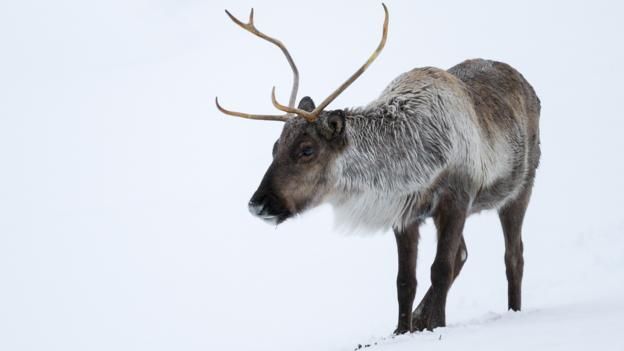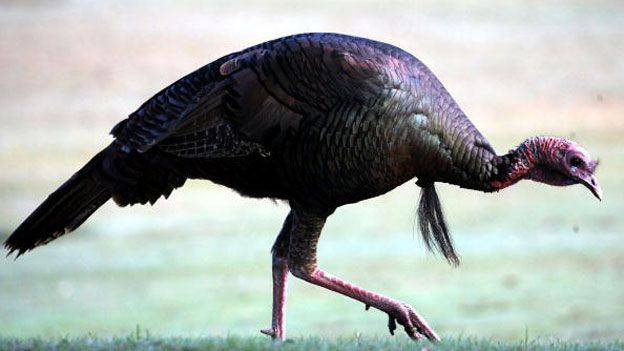圣诞季节的动物三宝
BBC双语(2023年11月29日)

雪中的知更鸟(图片来源:Andrew Howe / Getty Images)
冬天已经来了,圣诞即将到来。转眼之间,我们就会被印着知更鸟的圣诞贺卡层层包围,一边听着神奇驯鹿拉雪橇的故事,一边坐到晚饭桌前享用火鸡大餐。
这些野生动物是如何成为圣诞传统与节庆活动的吉祥物的?

知更鸟把羽毛抖松
知更鸟(拉丁学名:Erithacus rubecula)
再没有其它鸟类能像知更鸟一般使人想起那种圣诞的节日气氛和冬日的兴致了。这或许是因为,知更鸟属于仅有的几种会于圣诞当天在花园中唱歌的英国鸟类,它们用音调优美的歌声警告自己领地上的闯入者。
又或者是因为它们胸前长着鲜红色的羽毛,让身处萧瑟隆冬的人们看到一抹亮色、感到一线希望?
19世纪中叶,在首批邮局雇员中,有一些雇员身穿红色夹克衫,由此,人们常常以知更鸟的名字称呼他们,自那以后,圣诞贺卡上便渐渐开始出现知更鸟的形象。在这些早期贺卡的部分图片上,知更鸟往往用喙衔着一枚信封或一张明信片,像邮递员一样进行递送工作。
简而言之,邮递员因知更鸟而得了绰号,知更鸟因邮递员而拥有了人格化的角色。之后每年的圣诞贺卡、邮票和其它节日饰品上,都少不了要镶上知更鸟的图画。

在北美,驯鹿被称为北美驯鹿(caribou)(图片来源:lightpix / Getty Images)
驯鹿(拉丁学名:Rangifer tarandus)
时至今日,孩子们依然满心激动地等待着猛冲者(Dasher)、欢腾(Prancer)和其它会飞的驯鹿拉着圣诞老人的雪橇,满世界兜转,递送他们的礼物。
驯鹿最有可能是因1823年的一首题为《圣诞前夕》(The Night Before Christmas)的诗,而披上有魔力的外衣、走进圣诞传说当中的。红鼻子驯鹿鲁道夫(Rudolph)于二十世纪加入圣诞麋鹿队列,它的红鼻子照亮了平安夜雾蒙蒙的道路。
由于驯鹿(或按北美的叫法称北美驯鹿)的运动能效出色,体能胜过其它所有大型陆地动物;又鉴于许多生活在极地地区的人都选择用驯养的驯鹿来拉雪橇,因而,由驯鹿来担当传说中圣诞老人的坐骑,真真是再合适不过了。
驯鹿能够在极端寒冷、冰天雪地的北极生存下来。因其体格结实,皮毛温暖防冻,蹄型巨大,所以它们能够承受低至零下40摄氏度的极端低温。
一反其在平安夜空中飞驰的形象,我们较常看到的驯鹿正在进行它们一年一度的大迁徙。为了到达北极,北美驯鹿群可能要跨越5000多公里的旅程。
这种非凡的壮举,足以见证它们所驰行的距离比任何其它的陆地哺乳动物都要远,所以,也难怪它们能够在短短一个晚上将礼物送达世界各地,驯鹿是当仁不让的最佳圣诞坐骑!

进食中的雄性野生火鸡
野生火鸡(拉丁学名:Meleagris gallopavo)
对许多人来说,备有各种配料的火鸡是传统圣诞晚餐所不可或缺的大菜。据称,火鸡肉首次取代诸如孔雀肉、野猪肉、鹅肉等的肉类发生在十六世纪,在英国国王亨利八世(King Henry the VIII)把火鸡肉纳入他的圣诞大餐之后。但直到维多利亚时代,这一习俗才渐渐普及开来。
野生火鸡原本生长于美洲,是探险家将其引进到欧洲。随后,人们对它们进行了非常成功的驯化,以至于英国殖民者竟然又把它们带回到美国去养殖。
火鸡是体型最大的狩猎野禽,狩猎野禽科还包括了鹌鹑、松鸡和野鸡。在繁殖季节中,或者当火鸡感到兴奋时,它们头部的颜色就会在红、白、蓝三色中发生变化。
除了身为圣诞吉祥物以外,火鸡最为人所知的或许莫过于,雄性火鸡求偶时会发出快速的咯咯大叫声。人们也因此用“gobbler”来指称雄性火鸡。
(责编:友义)
Three animals that make the festive period
BBC News,29 November 2024
With winter well and truly upon us and the festive period fast approaching, we will soon be surrounded by robins on our Christmas cards, hear stories of magical reindeer pulling sleighs and sitting down to a turkey on our dinner table.
How did these wild animals become part of our festive traditions and celebrations?
Robin (Erithacus rubecula):
No other bird invokes the spirit of Christmas and winter like the robin. Perhaps it is because robins are one of the only UK birds that can be heard singing in the garden on Christmas day, warning off intruders from their territories with melodic song. Or is it their bright red breasts, which give a splash of colour and hope in the bleak midwinter?
Robins started to appear on Christmas cards in the mid-1800s after they gave their name to some of the first postal employees who wore red jackets, and who were often referred to as ‘robins’. On some of these early cards, the robin was often pictured carrying an envelope or postcard in its bill, delivering it like a postman.
Simply put, the robin gave its name to the postman and the postman gave its role to the robin. Every year since, robins have adorned our Christmas cards, stamps and other festive decorations.
Reindeer (Rangifer tarandus):
Children still wait excitedly for Dasher, Prancer and the other flying reindeer that pulled Santa Claus’s sleigh round the world to deliver their presents.
Most likely these magical deer made it into festive lore because of the 1823 poem titled The Night Before Christmas. Rudolph the red-nosed reindeer was a 20th-century addition to the team, lighting the way on a foggy Christmas Eve.
Reindeer, or caribou as they are known in North America, can outperform all other large land animals with their energy efficiency – so really are a fitting choice as the legendary Christmas sleigh-pullers. Since their domestication reindeer have been a sled-puller of choice for many people in the Polar Regions.
They are able to survive in the extreme cold and snow of the Arctic, withstanding extreme temperatures as low as -40°C thanks to their compact bodies, warm insulating fur and large hooves.
Rather than flying through the air on Christmas Eve, reindeer are more usually seen on their mammoth annual migration to the Arctic, during which the North American herds might travel for more than 5,000km.
This extraordinary feat that can see them travel further than any other land mammal, so they are the best contender for being able to deliver presents all over the world in just one night!
Wild turkey (Meleagris gallopavo):
For many a traditional Christmas dinner would not be the same without a turkey and all the trimmings. In England it first replaced meats such as peacock, boar and goose in the 16th-century, after King Henry the VIII was said to have dined on turkey as part of his Christmas feast. But it did not start to gain popularity until the Victorian times.
Native to the Americas, explorers brought wild turkeys to Europe, and their domestication was so successful that English settlers actually took them back to America to farm.
Turkeys are the largest member of the game bird family, which also includes partridges, grouse and pheasants. During the breeding season, or when they get excited, the colour of their head can change through shades of red, white and blue.
Beyond the festive period, turkeys are perhaps best known for the ‘gobbling’ calls made by the males to attract a mate, leading to the name 'gobbler'.